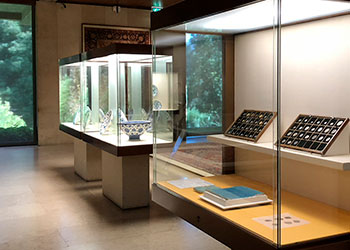New display case in the Eastern Islamic Art gallery

Artist Praneet Soi (Calcutta, 1971) was invited to present the museum’s penultimate exhibition of 2018 in the Conversations space, located in the Lower Gallery. In the museum, a display case in the Eastern Islamic Art gallery of the Founder’s Collection shows a number of objects that were part of Soi’s creative process as he explored and pondered possible connections between the Calouste Gulbenkian Museum and his own personal experiences. The display case establishes a link and dialogue between the museum and Praneet Soi’s exhibition, giving visitors a closer glimpse into the creative process behind the installation.
The subtitle of the exhibition [From Kashmir to Lisbon via Caldas] speaks to the idea of travel and to the very journey taken by the artist himself. During a trip to Srinagar, the capital of Kashmir, Soi came upon the ruins of a monument while walking along the banks of the Jhelum River: the mausoleum of Miran Zain, the mother of the 8th Sultan of Kashmir, Zain-Ul-Abidin (1420–1470). Captivated by the ceramic tiles lining the tomb, Soi became inspired to replicate the motif at the Bordallo Pinheiro Factory in Caldas da Rainha. After presenting his idea to the factory, Soi had the motif, which he dubbed Rainha [Queen], re-interpreted by the master craftsman Vítor Formiga.
In Lisbon, Soi spent time wandering both the streets of the city and the corridors of the museum and its storage areas. On one of his visits, the artist discovered an exquisite wooden chest that had been custom made for Calouste S. Gulbenkian. Comprised of various drawers, the small chest contained a valuable collection of Greek and Roman coins. Though instantly intrigued by the coins, Soi was more captivated by a group of coins from the Middle East dating from the pre-Islamic and Islamic periods. Originally given to Gulbenkian, these mysterious coins were never catalogued and are not considered part of the Collection. Fascinated by the imagery contained in the coins, Soi made rubbings of them on tracing paper, which he took away with him as proof of the experience.
The artist also visited the section of the museum’s storage dedicated to Eastern Islamic Art. While the Iznik tiles caught his eye, what stirred his curiosity were the reliefs and textures of a Persian tile dating from the Seljuk period, its colour reminded Soi of the ceramic tiles covering Miran’s mausoleum. As Soi’s project developed, his interests evolved as he grew more acquainted with the Calouste Gulbenkian Museum. The fortuitous discoveries he made on each visit to the museum served as a guide in his selection of objects, contributing to the idea of the museum as a factory, a space in constant transformation and a privileged locale for the conception of new ideas.
Diogo Marques